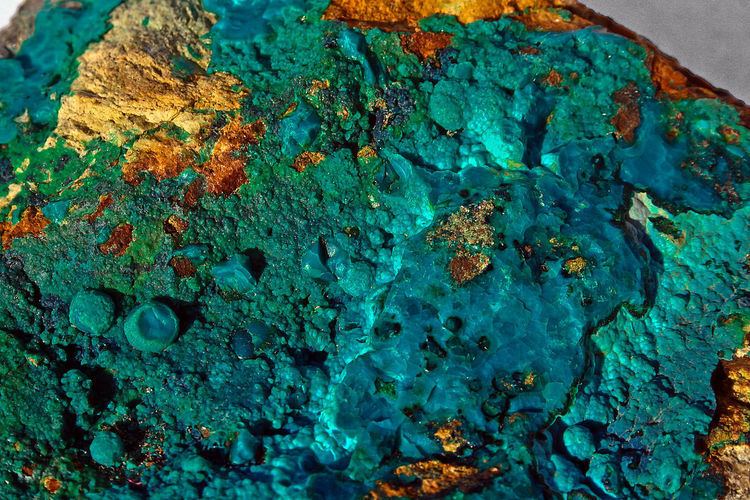Strunz classification 9.ED.20 | ||
 | ||
Formula(repeating unit) Cu2−xAlx(H2−xSi2O5)(OH)4·nH2O (x<1) Crystal system OrthorhombicUnknown space group Unit cell a = 5.7 Å, b = 8.9 Å,c = 6.7 Å; Z = 1 Color Blue, cyan or blue-green, green | ||
Chrysocolla is a hydrated copper phyllosilicate mineral with formula: Cu2−xAlx(H2−xSi2O5)(OH)4·nH2O (x<1) or (Cu,Al)2H2Si2O5(OH)4·nH2O. The structure of the mineral has been questioned, as spectrographic studies suggest material identified as chrysocolla may be a mixture of the copper hydroxide spertiniite and chalcedony.
Contents
Properties
Chrysocolla has a cyan (blue-green) color and is a minor ore of copper, having a hardness of 2.5 to 3.5.
Name and discovery
The name comes from the Ancient Greek: χρυσός κολλα (chrysos kolla), "gold glue", in allusion to the name of the material used to solder gold, and was first used by Theophrastus in 315 BCE.
Formation and occurrence
It is of secondary origin and forms in the oxidation zones of copper ore bodies. Associated minerals are quartz, limonite, azurite, malachite, cuprite, and other secondary copper minerals.
It is typically found as botryoidal or rounded masses and crusts, or vein fillings. Because of its light color, it is sometimes confused with turquoise.
Notable occurrences include Bacan Island Indonesia, Israel, Democratic Republic of Congo, Chile, Cornwall in England, and Arizona, Utah, Idaho, Colorado, New Mexico, Michigan, and Pennsylvania in the United States.
Questions regarding mineral status
A 2006 study has produced evidence that chrysocolla may be a microscopic mixture of the copper hydroxide mineral spertiniite, amorphous silica and water.
